by Angie Lavezzo, CFSA Communications Coordinator | Thursday, April 14, 2022 –
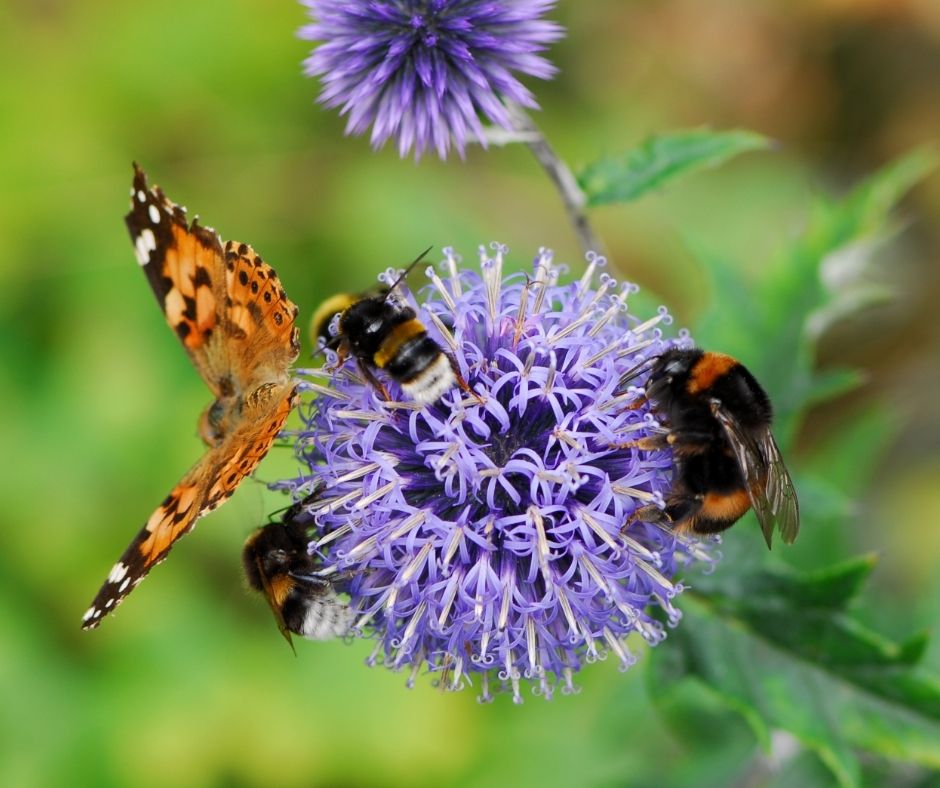
There are many good reasons to encourage pollinators on our farms and gardens. Without stewarding pollinators and insects as a whole, we cannot truly participate in a sustainable growing system. Supporting pollinators is the very definition of a mutually beneficial relationship. We help them survive, and they help increase our crop yields due to their handy pollination. Without them, our jobs would be a lot more difficult.
To attract and keep pollinators in our environment, we need to provide three basic needs: food in the form of plants, a place to raise their young, and a water source to sustain them. Encouraging pollinators gives us more than just added beauty. Who doesn’t love watching a butterfly flit from bloom to bloom?
Inspired by the 25th anniversary of the Piedmont Farm Tour, which happens annually during Earth Day weekend, we’ve compiled a list of 25 ways to help our pollinator friends survive and thrive.
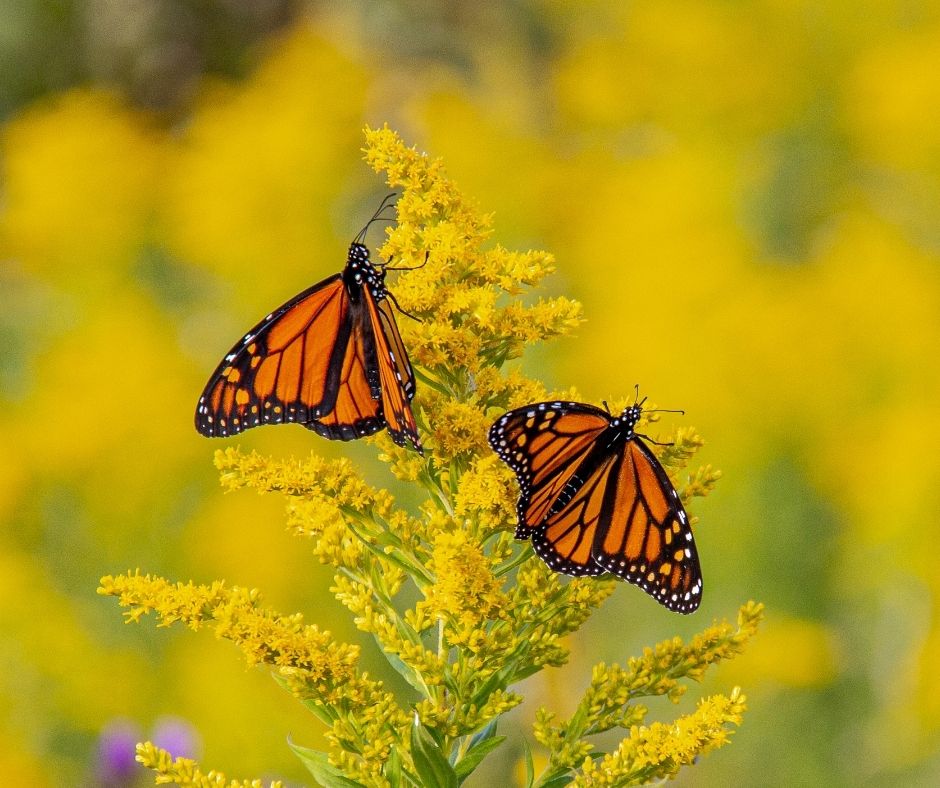
Planting for Food
1. Plant native! Native plants should take priority when choosing varieties for pollinators. Native plants will grow best in your local soil and climate while providing high-quality food for your friends. Here’s a handy NC list and SC list.
2. Plant open-pollinated varieties. If you can’t plant native, choose open-pollinated. Open-pollinated varieties will function as intended, whereas hybrid types are bred for beauty and functionality, often at the expense of nectar or pollen production. For example, many hybrid sunflowers have the pollen purposefully bred out so that cut flower farmers will not have a messy bouquet.
3. Be confident in the source of your seeds. Avoid seeds pre-treated with pesticides; many are systemic, meaning the seed carries the chemicals into the flower’s body and is present in the pollen and nectar.
4. Buy plants from a local farmer or greenhouse you trust. Alternatively, start your own plants from seeds or cuttings. If a grower cannot confirm the absence of pesticide treatment, it’s safest to assume it is probably there. Planting a lovely flat of zinnias won’t help the bees if it makes them sick or worse from lingering toxins.
5. Think about providing blooms for all seasons. It is a veritable bee banquet in the summer months, but the other three seasons can be scarce in the food department. Many beautiful choices bloom early and late in the growing season, and there are even a few choices bloom in the winter, like hellebore and heather that can provide food on warm days when foraging is favorable.
6. Plant in clusters. Groups of three or more of the same plant together make it easier for pollinators to forage. They can see the grouping of color better when flying overhead, and pollen transfer between accepting plants is more efficient, leading to better blossom and fruit production.
7. Think about birds, too. Native and pollinator plants are needed to support songbirds by supplying food for the insects that most baby birds require. In late spring and early summer, 96% of terrestrial birds are rearing their young on the insects from our gardens. For some species, this can be more than 5,000 insects per clutch!
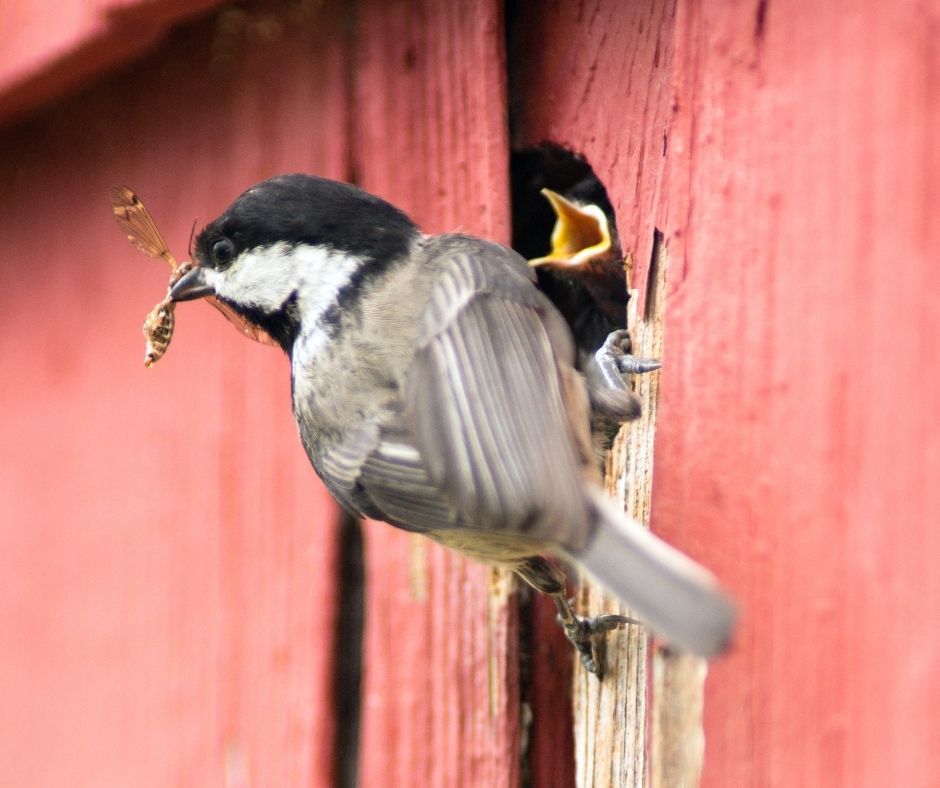
8. Choose plants with multiple purposes. If you don’t have a lot of room, consider plants that check a few boxes at once. Maybe you’re interested in medicinal herbs or having a patch of flowers for fresh bouquets? Countless choices can provide that basic need while feeding butterflies and bees.
9. Think about host plants for butterflies. Butterflies don’t just rely on plants for food; they also have specific plant needs to rear their young. Butterflies lay their eggs on “host” plants, where, when hatched, the caterpillars will eat the vegetation off that plant in preparation for forming their chrysalis. So while butterflies may pass through to eat your nectar, provide host plants if you want them to stay.
10. Plant a range of flower sizes. The flowers that attract hummingbirds are not the same as those that attract bees or beneficial wasps. The flower’s shape makes it easier or harder for different species to access the nectar and pollen. Generally, larger flowers, often trumpet-shaped, seem attractive to hummingbirds and songbirds.
11. Avoid spraying chemicals in your garden. Even organic treatments can be harmful to insects. If you must spray to save a crop, follow the instructions carefully, avoid spraying on windy days, and apply your treatment at dusk when fewer pollinators are out foraging.
12. Install a perennial border. If food growing is your main objective, you can reap the benefits of attracting pollinators and beneficial insects to your crops by establishing a row dedicated to flowers and shrubs that serve as both food and habitat. These can be whatever you like and ideally are designed to be low or no maintenance once established.
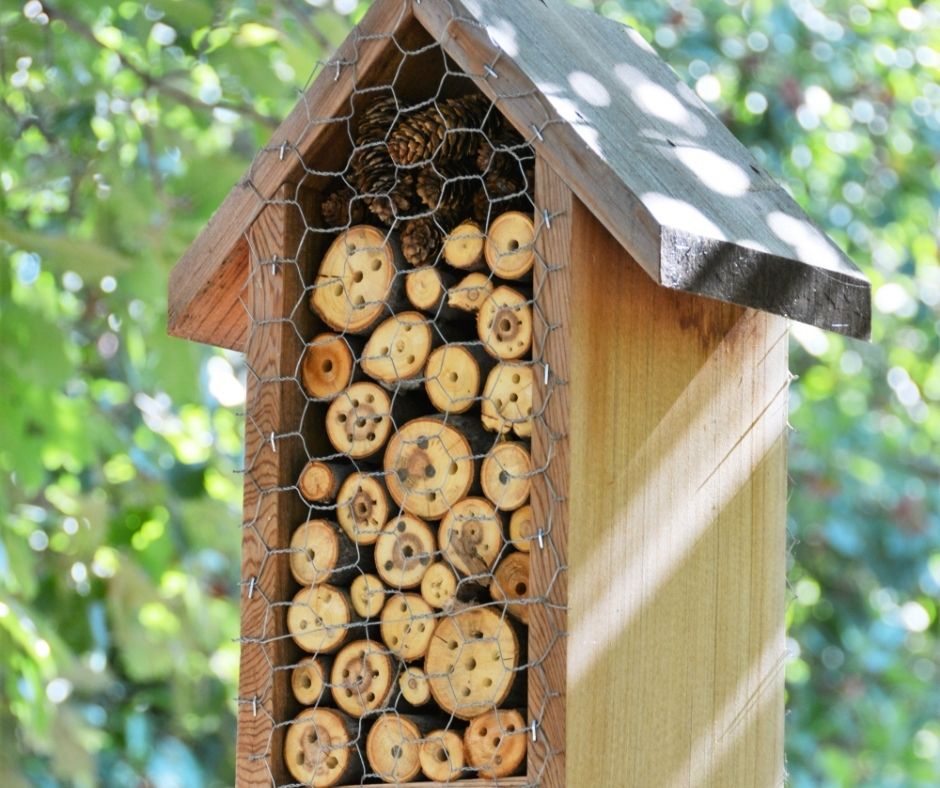
Providing Habitat
13. Put up native bee houses. Making your own is simple, and there are fantastic plans to be had for free on the web. Be cautious when buying premade boxes. Many commercially available options are inadequately sized. Tunnels for nesting should always be 6-7” deep and the trend in stores is 3-4”. The practical reason for this being problematic is that most tunnel nesters lay their female eggs tucked into the back of the tubes, where they will be protected from possible predators, and the male eggs fill the front half of the tubes. If the tubes are too short, she will lay fewer female eggs, resulting in a decreased population the following year.
14. Grow your own nesting material. Many common plants like raspberry, bee balm, elderberry, and even okra naturally have hollow stems and can be left in place for bees to use or harvested by you and cut to size to use as fresh material in your bee boxes. Nesting material can also be made from untreated wood.
15. Make use of existing debris. Most native bees are solitary and lay eggs in tiny tunnels in dead trees, fallen branches, hollow stems, or sandy soil. Leave standing dead trees, fallen logs, and bare patches of sandy soil.
16. Attract hummingbirds by planting dense shrubs for nesting. Hummingbirds like to nest near known nectar sources. Shrubbery and small, deciduous trees are common places to find their tiny, expandable nests.
17. Put up birdhouses. Our nation’s songbirds are in trouble. Loss of habitat, broad-spectrum pesticides killing their food, and now this puzzling affliction doesn’t leave them in a good place. We can offer safe haven to these critical members of our ecosystem by installing some houses for them to overwinter in and raise their young.
18. Install a bat house. While not technically pollinators in our part of the world, bats are still a keystone species. Like our bird friends, bats suffer from the same food and habitat loss and have their own mysterious health conditions. Putting up a bat box is one small gesture to offer refuge and safety.
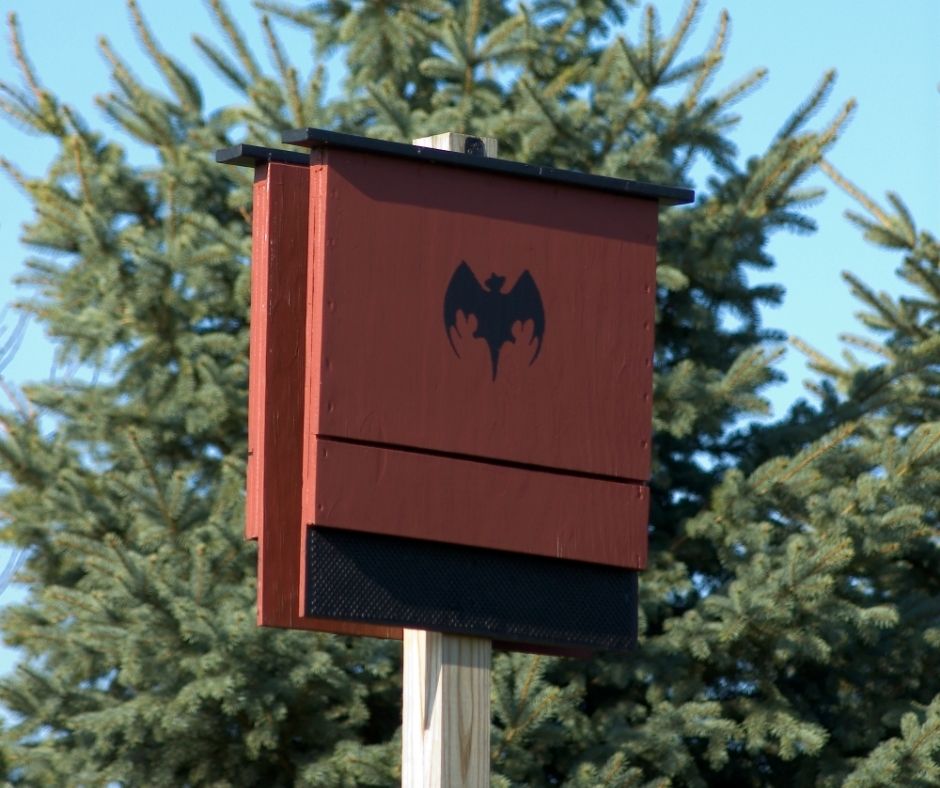
19. Leave bare patches free of grass. Ground nesting bees like bumblebees have trouble moving through grass and thatch to reach the soil where they like to dig to nest. Out-of-the-way spots at the edge of your property are a good place to create these spots so they can remain relatively undisturbed.
20. Consider putting up feeders for hummingbirds and songbirds. But maybe not year-round. In the spring and summer months, we would like birds to be eating insects and practice their foraging skills. There are around 30 species of songbird that overwinter in the Carolinas, and benefit from having a food source they don’t have to work so hard for. Giving hummingbirds a place to feed when they are returning from and leaving for their spring and autumn migrations is a great boon for them when making such long a journey.
21. Build a brush pile. Brush piles are used by many species, including being hibernation sites for mourning cloaks and other butterflies, offering places of soil access for ground-nesting bees, and daytime shelter for fireflies.
22. Build a rock pile or rock wall. Leafcutter bees, some types of digger bees, and bumblebees use rocky encampments for shelter and places to rear young.
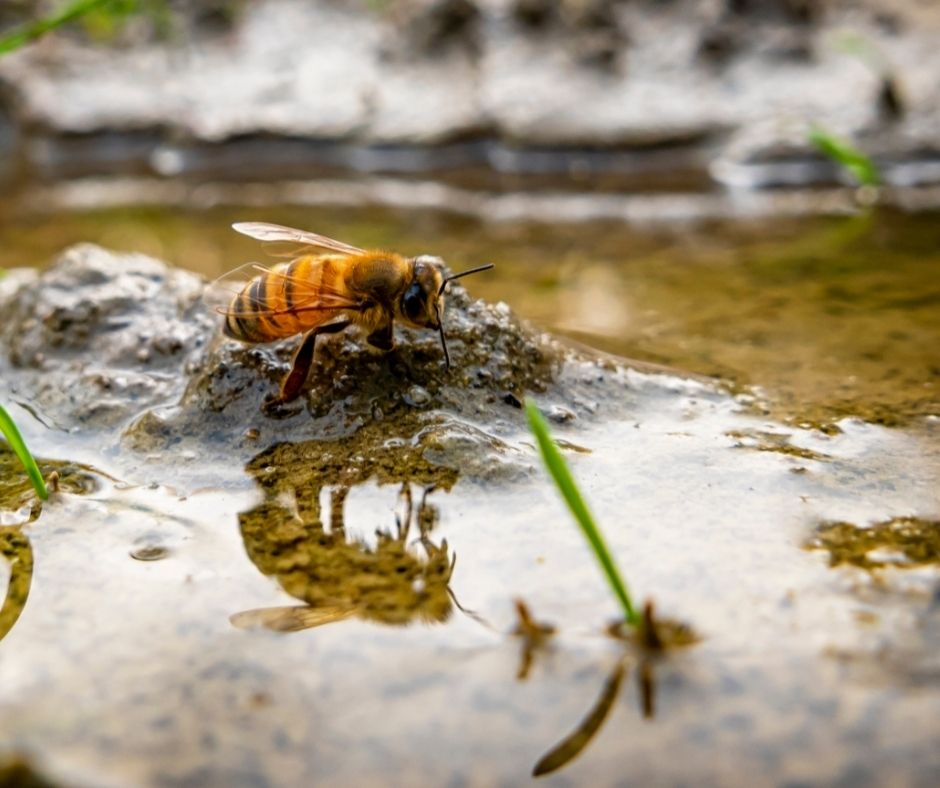
Water
23. Provide different types of water vessels for your friends. Place shallow basins such as birdbaths or ceramic saucers near potential nesting sites. Be sure to put marbles or stones in the bowl for bees and wasps to perch on, and run the stones up one side of the bowl so if someone falls in, they can climb out. Bees are terrible swimmers, after all.
24. Change the water regularly. Mosquitos are no fun, and keeping the water fresh will prevent their larvae from taking up residence. Don’t worry about dirt or other organic matter in the water. The minerals present in the dirt can be beneficial for the bees.
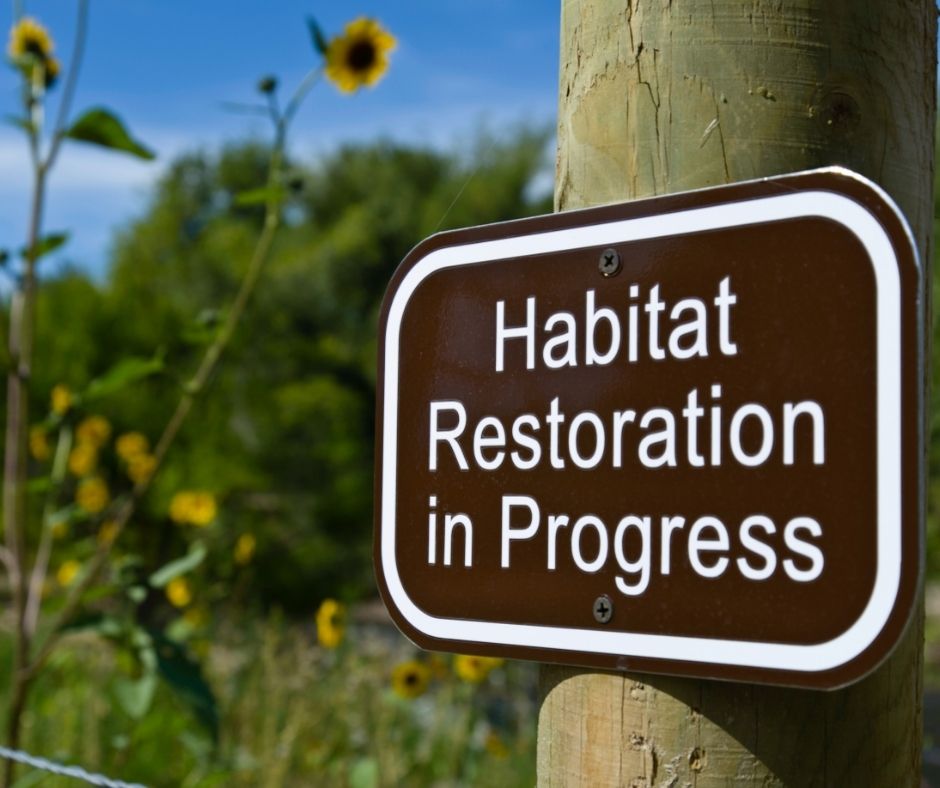
Finally
25. Consider putting up a sign announcing your pollinator-friendly habitat. This can help explain your objective to visitors and serve as an opportunity to inspire others to think about how they might make changes in their landscapes to support and encourage pollinators.
Sustainable farming practices and insects go hand in hand. They are part of everything we do when working with plants and animals. We hope this list has inspired you to work with our little friends rather than against them. Pollinators of all kinds are beautiful, interesting, and worth our support and protection.
This Earth Day, get yourself a good insect identification book and walk around to see how many different species you find. Or have a get-together with friends and make native bee houses together. Maybe a trip to your local greenhouse to buy a few pollinator plants is more your speed? Anything you can do from this list will be a step in the right direction for healthy and happy ecosystems.
If you want to celebrate Earth Day weekend and seeing some of these suggestions in practice, grab a ticket to CFSA’s Piedmont Farm Tour.


